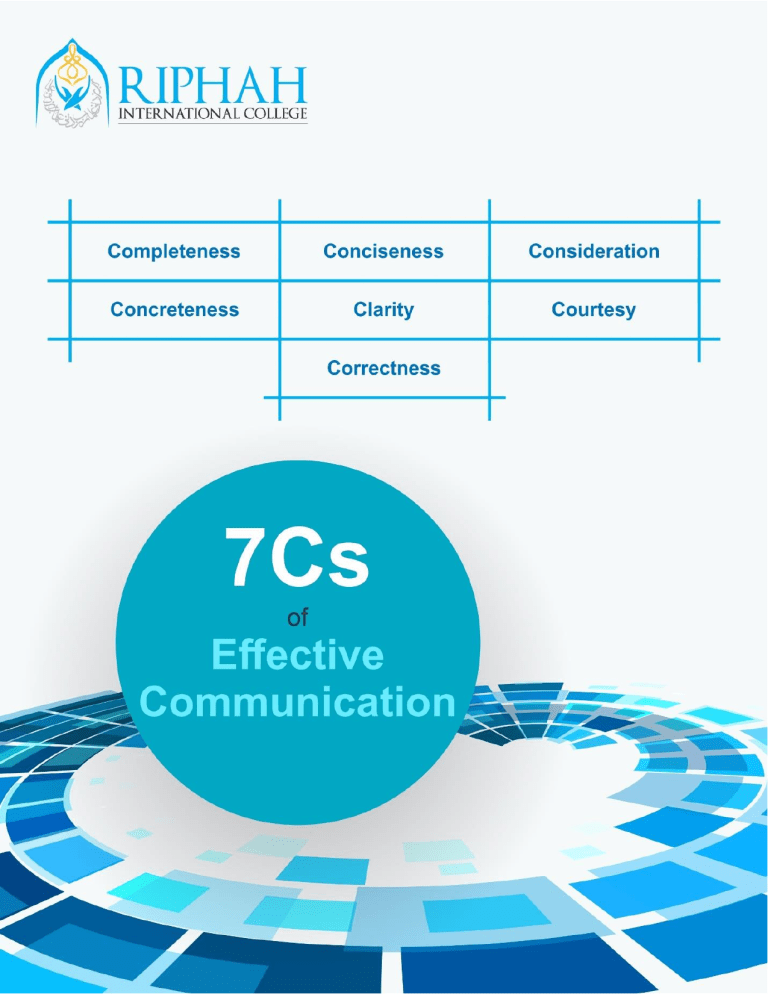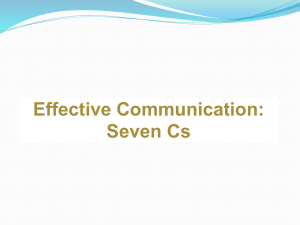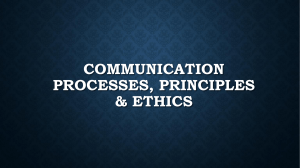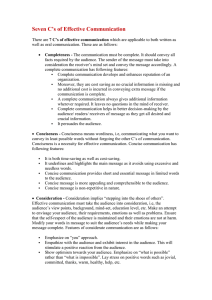
1 Effective Communications (7 Cs) When we talk about “Effective Communication” one thing that comes in mind, what are the basic principles of “Effective Communication” These principles prove us how your message can become effective for your target group. These principles also establish style and importance of the message. These principles are commonly known as “7 Cs of Effective Communication.” 7Cs of Effective Communication 1. Completeness 2. Conciseness 3. Consideration 4. Concreteness 5. Clarity 6. Courtesy 7. Correctness 1. Completeness The communication must be complete. It should convey all facts required by the audience. The sender of the message must take into consideration the receiver’s mind set and convey the message accordingly. A complete communication has following features: Complete communication develops and enhances reputation of an organization. Moreover, they are cost saving as no crucial information is missing and no additional cost is incurred in conveying extra message if the communication is complete. A complete communication always gives additional information wherever required. It leaves no questions in the mind of receiver. Complete communication helps in better decision-making by the audience / readers / receivers of message as they get all desired and crucial information. It persuades the audience to listen and evaluate emphatically. 1.1 The Significance of 5 five W’s The five W’s completes the answer in multidimensional aspects. WHO? WHAT? WHEN? WHERE? WHY? 2 The five questions -method is useful when you write requests, announcements, or other informative messages. For instance, to order (request) anything, 5-question method makes clear WHO wants it? WHAT you want? WHEN you need it? WHERE it is to be use and WHY you want it.? 1.2 Conclusion of Completeness At the end we can say that, you must provide him: 1. All necessary information as requested by him. 2. Answers to his all questions carefully. 3. Provide some more information, which he is not requiring, just to maintain good relations. 2. Conciseness Conciseness means “convey the message by using smallest words”. “Conciseness is the prerequisite to effective business communication.” As you know that all executives have very short time. Hence a concise message saves the time and expenses for both the parties. 2.1 How to achieve Conciseness? For achieving the conciseness you have to consider the following: Avoid wordy expression. Include only relevant material. Avoid unnecessary repetition 2.1.1 Avoid Wordy Expression e.g. wordy: at this time. Instead of “at this time” you can just use only a concise word: NOW Always try to use “To the point Approach” in business Scenario perspective. 2.1.2 Include only Relevant Information Always try to provide only relevant information to the receiver of the message. Observe the following suggestions to “Include only relevant information.” Stick to the purpose of message Delete irrelevant words Avoid long introduction, unnecessary explanation etc. Get to the important point concisely. 3 2.1.3 Avoid Un-Necessary Repetition Sometimes repetition is necessary for focusing some special issue. But when the same thing is said without two or three reasons, the message become wordy and boring. That’s why try to avoid un-necessary repetition. 2.1.4 Eliminate un-necessary words Use shorter name after you have mentioned the long once. e.g. Spectrum Communications Private Limited use Spectrum. Use pronouns or initials e.g. Instead of Lahore Development Authority use LDA or You can use IT for Information Technology. (Keeping in views that receiver knows about these terms) 3. Consideration Consideration means – To consider the receiver’s Interest/Intention. It is very important in effective communication while writing a message you should always keep in mind your target group or person. Consideration is very important “C” among all the seven C’s. 3.1 Ways to Indicate Consideration Focus on “you” instead of “I” or “We”. Show audience benefit or interest of the receiver. Emphasize positive, pleasant facts 3.2 You Attitude Always write a message in such a way how reader should be benefited from it. Reader may react positively when benefits are shown to him. Always try to address his/her needs and wants. Always show/write to reader, what has been done so far as his/her query is concerned. 4 4. Concreteness It means that message should be specific instead of general. Misunderstanding of words creates problems for both parties (sender and receiver). When you talk to your senior always use facts and figures instead of generic or irrelevant information. 4.1 Guidelines of Concreteness The following guidelines should help you to achieve the Concreteness. o General: Police File is very good program and stood first in the rating. o Concrete: Police File rating of last week’s episodes are ________It stood first in rating. Always write on a very solid ground. It should definitely create good image as well. 5. Clarity Accurately is purpose of clarity: In effective communication the message should be very much clear, so that reader can understand it easily. You should always choose precise, familiar and easy words. Construct effective sentences and paragraphs Examples Familiar after home invoice Less familiar words subsequent domicile statement for payments 6. Courtesy Knowing your audience allows you to use statements of courtesy; be aware of your message receiver. True courtesy involves being aware not only of the perspective of others, but also their feelings. It is not just politeness with automatic placing of “please” and “Thank you”. “Warm regards.” “Feel indebted and obliged.” Although Applying socially accepted manners is a form of courtesy, rather it is politeness that grows out respect and concern for others. Courteous communication generates a special tone in their writing and speaking. 5 6.1 How to generate a courteous tone? The following are suggestions for generating a courteous tone: Be sincerely tactful, thoughtful and appreciative. Use expressions that show respect for the others. Choose fair expressions. Be sincerely tactful, thoughtful and appreciative. Though few people are intentionally hasty or blunt, these negative traits are common cause of discourtesy, avoid expression like those in the left hand column below; rephrase them as shown in the right-hand column Tactless, Blunt More Tactful Stupid letter; I can’t understand I should understand it, as there is no confusing word in this letter, could you please explain it once again..? It’s your fault, you did not properly read my latest e-mail Sometimes my wording is not precise; let me try again 6.2 Thoughtfulness and Appreciation: a) Writers who send pleasant, courteous messages of deserved congratulations and appreciation (to a person inside & outside) help to build goodwill. b) The value of goodwill or public esteem for the firm is priceless. 7. Correctness At the core of correctness is proper grammar and spelling. However, message must be perfect grammatically and mechanically. The term correctness, as applied to business messages also means three characteristics; a. Use the right level of language b. Check the accuracy of figures, facts and words. c. Maintain acceptable writing mechanics. 6 7.1 There are three levels of language a. b. c. d. e. f. formal informal Substandard. Take a quick guess What kind of writing is associated with each level? What is the style of each? Formal: writing is often associated with top-level government agreements, academic writing, legal documents and other material where formality is demanded. Informal: writing is more characteristic of business writing. Here you use words that are short, well-known and conversational. e.g. More Formal less formal Participate Attempt Determine Utilize Interrogate Join Try Find out Use Question 7.2 Substandard Words Avoid substandard language. Using correct words, incorrect grammar, Faulty pronunciation all suggest as inability to use good English. Substandard More Acceptable Ain’t isn’t, aren’t Can’t hardly can hardly Aim to proving aim to prove Desirous to desirous of Stoled stolen 7 7.3 Facts, Figures Accuracy Check Accuracy of Facts, Figures and words: a. It is impossible to convey meaning precisely, through words, from the head of the sender to a receiver. b. Our goal is to be as precise as possible, which means checking and double-checking and double-checking to ensure that the figures, facts and words you use are correct. “A good check of your data is to have another person read and comment on the validity of the material.” 7.4 Proper use of Confusing Words Our Language (any) is constantly changing. In fact, even dictionaries cannot keep up with rapid change in our language. Following words often confusing in usage: Accept, Except: Accept is a verb and means to receive whereas except is a verb or a preposition and relates to omitting or leaving out. Nervous, Eager: Whereas nervous implies worry, eager conveys keen desire 8 Plagiarism Policy Plagiarism is the practice of taking someone else's work or ideas and passing them off as one's own. It's good to learn from someone else and take help from the internet, especially for analyzing gaps in the current state of the art, but the proper citation is required. Teachers are required to look into the plagiarism possibilities in term projects. In the case of Plagiarism, students will be assigned an "F" grade in the relevant course and their names might be displayed over notice boards based upon the severity of the plagiarism and strength of evidence. 9




